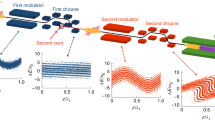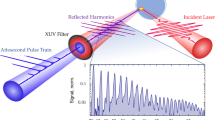Abstract
When an intense laser pulse is focused into a gas, the light–atom interaction that occurs as atoms are ionized results in an extremely nonlinear optical process1,2,3—the generation of high harmonics of the driving laser frequency. Harmonics that extend up to orders of about 300 have been reported4,5, some corresponding to photon energies in excess of 500 eV. Because this technique is simple to implement and generates coherent, laser-like, soft X-ray beams, it is currently being developed for applications in science and technology; these include probing the dynamics in chemical and materials systems6 and imaging7. Here we report that by carefully tailoring the shape8 of intense light pulses, we can control9,10 the interaction of light with an atom during ionization, improving the efficiency of X-ray generation by an order of magnitude. We demonstrate that it is possible to tune the spectral characteristics of the emitted radiation, and to steer the interaction between different orders of nonlinear processes.
This is a preview of subscription content, access via your institution
Access options
Subscribe to this journal
Receive 51 print issues and online access
$199.00 per year
only $3.90 per issue
Buy this article
- Purchase on Springer Link
- Instant access to full article PDF
Prices may be subject to local taxes which are calculated during checkout



Similar content being viewed by others
References
McPherson, A. et al. Studies of multiphoton production of vacuum-ultraviolet radiation in the rare gasses. J. Opt. Soc. Am. B 4, 595-601 (1987).
Macklin, J. J., Kmetec, J. D. & Gordon, C. L. III High-order harmonic generation using intense femtosecond pulses. Phys. Rev. Lett. 70, 766–769 (1993).
L'Huillier, A. & Balcou, P. High-order harmonic generation in rare gases with a 1-ps 1053 nm laser. Phys. Rev. Lett. 70, 774–777 (1993).
Chang, Z., Rundquist, A., Wang, H., Murnane, M. M. & Kapteyn, H. C. Generation of coherent X-rays at 2.7 nm using high harmonics. Phys. Rev. Lett. 79, 2967 –2970 (1997).
Spielmann, C. et al. Generation of coherent X-rays in the water window using 5-femtosecond laser pulses. Science 278, 661– 664 (1997).
Rettenberger, A., Leiderer, P., Probst, M. & Haight, R. Ultrafast electron transport in layered semiconductors studied with femtosecond-laser photoemission. Phys. Rev. B 56, 12092– 12095 (1997).
Descamps, D. et al. Extreme ultraviolet interferometry measurements with high-order harmonics. Opt. Lett. 25, 135– 137 (2000).
Wefers, M. & Nelson, K. Analysis of programmable ultrashort waveform generation using liquid-crystal spatial light-modulators. J. Opt. Soc. Am. B 12, 1343–1362 (1995).
Judson, R. & Rabitz, H. Teaching lasers to control molecules. Phys. Rev. Lett. 68, 1500– 1503 (1992).
Warren, W., Rabitz, H. & Dahleh, M. Coherent control of quantum dynamics: the dream is alive. Science 259, 1581–1589 (1993).
Weinacht, T. C., Ahn, J. & Bucksbaum, P. H. Controlling the shape of a quantum wavefunction. Nature 397, 233–235 (1999).
Meshulach, D. & Silberberg, Y. Coherent quantum control of two-photon transitions by a femtosecond laser pulse. Nature 396 , 239–242 (1998).
Meshulach, D. & Silberberg, Y. Coherent quantum control of multiphoton transitions by shaped ultrashort optical pulses. Phys. Rev. A 60, 1287–1292 (1999).
Assion, A. et al. Control of chemical reactions by feedback-optimized phase-shaped femtosecond laser pulses. Science 282, 919 –922 (1998).
Rundquist, A. et al. Phase-matched generation of coherent soft X-rays. Science 280, 1412–1415 ( 1998).
Roos, L. et al. Controlling phase matching of high-order harmonic generation by manipulating the fundamental field. Phys. Rev. A 60, 5010–5018 (1999).
Altucci, C., Bruzzese, R., D'Antuoni, D., de Lisio, C. & Solimeno, S. Harmonic generation in gases by use of Bessel-Gauss laser beams. J. Opt. Soc. Am. B 17, 34–42 (2000).
Zhou, J., Peatross, J., Murnane, M. M., Kapteyn, H. C. & Christov, I. P. Enhanced high harmonic generation using 25 femtosecond laser pulses. Phys. Rev. Lett. 76, 752–755 (1996).
Chang, Z., Rundquist, A., Wang, H., Kapteyn, H. C. & Murnane, M. M. Temporal phase control of soft-X-Ray harmonic emission. Phys. Rev. A 58, R30–R33 (1998).
Salieres, P., Antoine, P., de Bohan, A. & Lewenstein, M. Temporal and spectral tailoring of high-order harmonics. Phys. Rev. Lett. 81, 5544–5547 (1998).
Zeek, E. et al. Adaptive pulse compression for transform-limited 15fs high-energy pulse generation. Opt. Lett. 25, 587– 589 (2000).
Zeek, E. et al. Pulse compression using deformable mirrors. Opt. Lett. 24, 493–495 ( 1999).
Yelin, D., Meshulach, D. & Silberberg, Y. Adaptive femtosecond pulse compression. Opt. Lett. 22, 1793–1795 (1997).
DeLong, K. W., Trebino, R., Hunter, J. & White, W. E. Frequency-resolved optical gating with the use of second-harmonic generation. J. Opt. Soc. Am. B 11, 2206–2215 (1994).
Kulander, K. C., Schafer, K. J. & Krause, J. L. in Super-Intense Laser-Atom Physics (eds Piraux, B., L'Huillier, A. & Rzazewski, K.) 95–110 (Plenum, New York, 1993).
Lewenstein, M., Balcou, P., Ivanov, M. Y. & Corkum, P. B. Theory of high-harmonic generation of low-frequency laser fields. Phys. Rev. A 49, 2117–2132 (1993).
Ditmire, T. et al. Nuclear fusion from explosions of femtosecond laser-heated deuterium clusters. Nature 398, 489– 492 (1999).
LeBlanc, S. P. et al. Temporal characterization of a self-modulated laser wakefield. Phys. Rev. Lett. 77, 5381– 5384 (1996).
de Boeij, W. P., Pshenichnikov, M. S. & Wiersma, D. A. Ultrafast solvation dynamics explored by femtosecond photon echo spectroscopies. Ann. Rev. Phys. Chem. 49 , 99–123 (1998).
Schoenlein, R. W. et al. Femtosecond X-ray pulses at 0.4 angstrom generated by 90 degrees Thomson scattering: A tool for probing the structural dynamics of materials. Science 274, 236–238 (1996).
Acknowledgements
We gratefully acknowledge support for this work from the Department of Energy and the National Science Foundation.
Author information
Authors and Affiliations
Corresponding author
Rights and permissions
About this article
Cite this article
Bartels, R., Backus, S., Zeek, E. et al. Shaped-pulse optimization of coherent emission of high-harmonic soft X-rays. Nature 406, 164–166 (2000). https://doi.org/10.1038/35018029
Received:
Accepted:
Issue Date:
DOI: https://doi.org/10.1038/35018029
This article is cited by
-
Intense isolated attosecond pulses from two-color few-cycle laser driven relativistic surface plasma
Scientific Reports (2022)
-
Machine learning and applications in ultrafast photonics
Nature Photonics (2021)
-
Generation of even and odd high harmonics in resonant metasurfaces using single and multiple ultra-intense laser pulses
Nature Communications (2021)
-
Attosecond pulse shaping using a seeded free-electron laser
Nature (2020)
-
Tuning up-conversion luminescence in Er3+-doped glass ceramic by phase-shaped femtosecond laser field with optimal feedback control
Frontiers of Physics (2019)
Comments
By submitting a comment you agree to abide by our Terms and Community Guidelines. If you find something abusive or that does not comply with our terms or guidelines please flag it as inappropriate.



